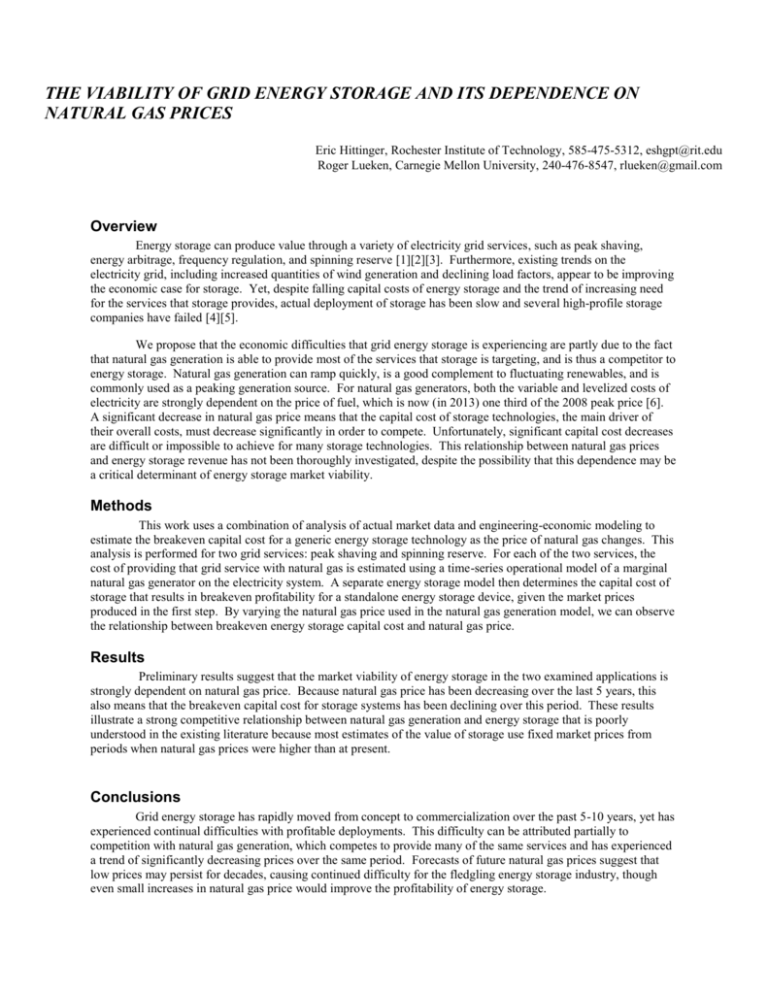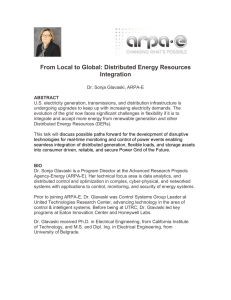Overview - United States Association for Energy Economics
advertisement

THE VIABILITY OF GRID ENERGY STORAGE AND ITS DEPENDENCE ON NATURAL GAS PRICES Eric Hittinger, Rochester Institute of Technology, 585-475-5312, eshgpt@rit.edu Roger Lueken, Carnegie Mellon University, 240-476-8547, rlueken@gmail.com Overview Energy storage can produce value through a variety of electricity grid services, such as peak shaving, energy arbitrage, frequency regulation, and spinning reserve [1][2][3]. Furthermore, existing trends on the electricity grid, including increased quantities of wind generation and declining load factors, appear to be improving the economic case for storage. Yet, despite falling capital costs of energy storage and the trend of increasing need for the services that storage provides, actual deployment of storage has been slow and several high-profile storage companies have failed [4][5]. We propose that the economic difficulties that grid energy storage is experiencing are partly due to the fact that natural gas generation is able to provide most of the services that storage is targeting, and is thus a competitor to energy storage. Natural gas generation can ramp quickly, is a good complement to fluctuating renewables, and is commonly used as a peaking generation source. For natural gas generators, both the variable and levelized costs of electricity are strongly dependent on the price of fuel, which is now (in 2013) one third of the 2008 peak price [6]. A significant decrease in natural gas price means that the capital cost of storage technologies, the main driver of their overall costs, must decrease significantly in order to compete. Unfortunately, significant capital cost decreases are difficult or impossible to achieve for many storage technologies. This relationship between natural gas prices and energy storage revenue has not been thoroughly investigated, despite the possibility that this dependence may be a critical determinant of energy storage market viability. Methods This work uses a combination of analysis of actual market data and engineering-economic modeling to estimate the breakeven capital cost for a generic energy storage technology as the price of natural gas changes. This analysis is performed for two grid services: peak shaving and spinning reserve. For each of the two services, the cost of providing that grid service with natural gas is estimated using a time-series operational model of a marginal natural gas generator on the electricity system. A separate energy storage model then determines the capital cost of storage that results in breakeven profitability for a standalone energy storage device, given the market prices produced in the first step. By varying the natural gas price used in the natural gas generation model, we can observe the relationship between breakeven energy storage capital cost and natural gas price. Results Preliminary results suggest that the market viability of energy storage in the two examined applications is strongly dependent on natural gas price. Because natural gas price has been decreasing over the last 5 years, this also means that the breakeven capital cost for storage systems has been declining over this period. These results illustrate a strong competitive relationship between natural gas generation and energy storage that is poorly understood in the existing literature because most estimates of the value of storage use fixed market prices from periods when natural gas prices were higher than at present. Conclusions Grid energy storage has rapidly moved from concept to commercialization over the past 5-10 years, yet has experienced continual difficulties with profitable deployments. This difficulty can be attributed partially to competition with natural gas generation, which competes to provide many of the same services and has experienced a trend of significantly decreasing prices over the same period. Forecasts of future natural gas prices suggest that low prices may persist for decades, causing continued difficulty for the fledgling energy storage industry, though even small increases in natural gas price would improve the profitability of energy storage. References [1] J. Eyer and G. Corey, "Energy Storage for the Electricity Grid: Benefits and Market Potential Assessment Guide," 2010. [2] Electricity Storage Association, “Energy Storage Benefits,” 2011. [Online]. Available: http://www.electricitystorage.org/technology/energy_storage_benefits/benefit_categories. [Accessed January 2014]. [3] J. Eyer, J. Iannucci and G. Corey, “Energy Storage Benefits and Market Analysis Handbook,” 2004. [4] B. Vlasic and M. Wald, “Maker of Batteries Files for Bankruptcy,” 17 October 2012. [Online]. Available: http://www.nytimes.com/2012/10/17/business/battery-maker-a123-systems-files-for-bankruptcy.html?_r=0. [Accessed January 2014]. [5] D. McCarty, “Beacon Power, Backed by U.S. Loan Guarantees, Files Bankruptcy,” 31 October 2011. [Online]. Available: http://www.businessweek.com/news/2011-10-31/beacon-power-backed-by-u-s-loan-guarantees-filesbankruptcy.html. [Accessed January 2014]. [6] US Energy Information Administration, “Natural Gas,” January 2014. [Online]. Available: http://www.eia.gov/dnav/ng/ng_pri_sum_dcu_nus_m.htm. [Accessed January 2014].











